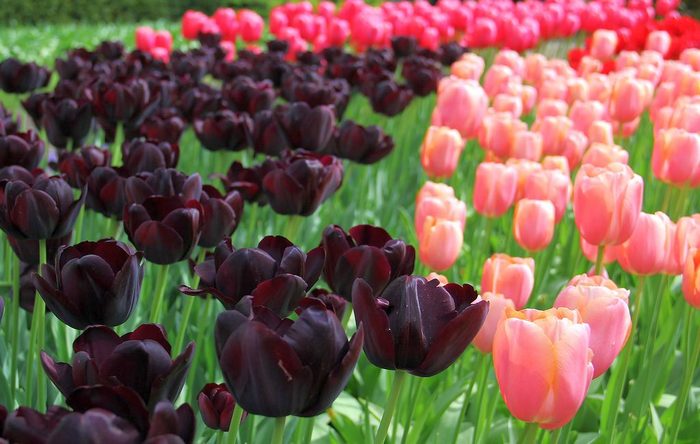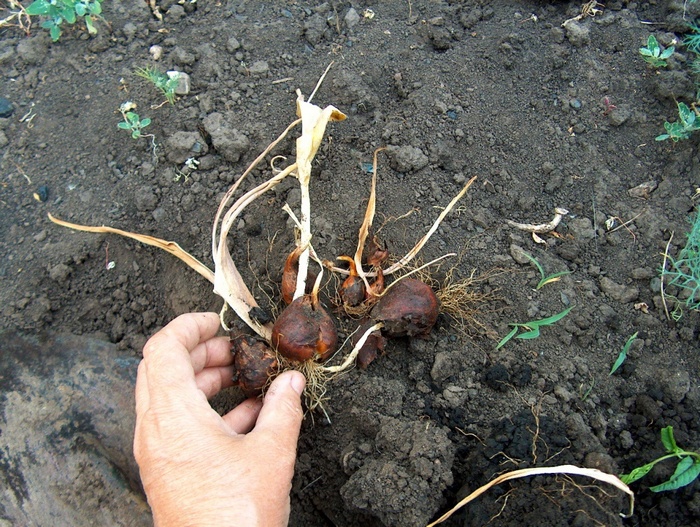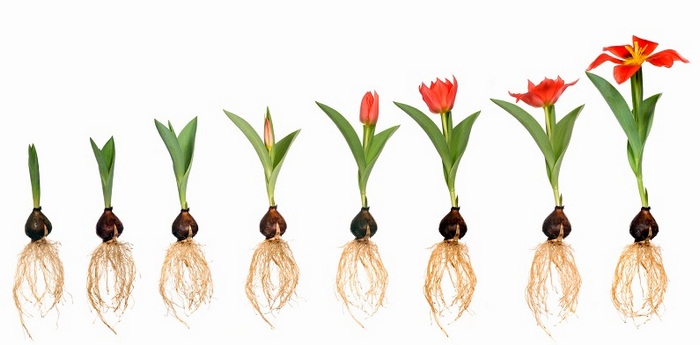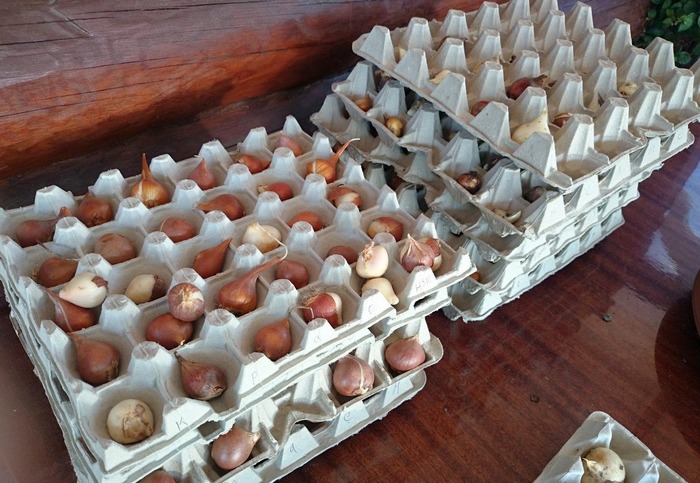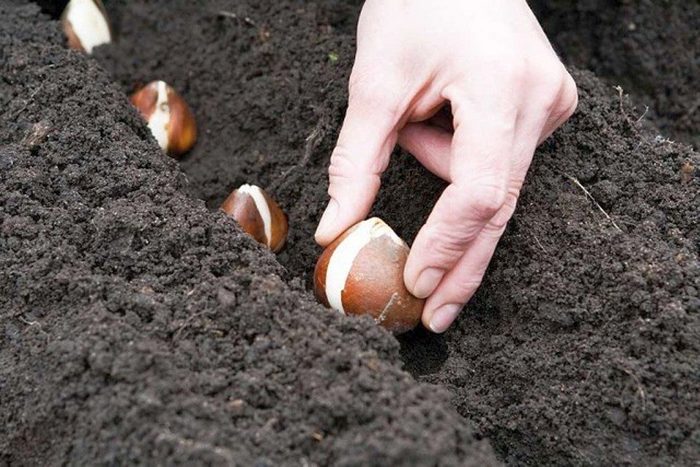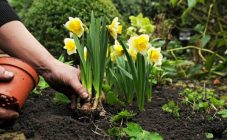Content:
Tulips are practically the first of the flowers to open their buds in early spring, but their flowering is very short-lived. In order to be able to admire them again with the arrival of the next season, you need to properly save the bulbs until the next planting.
Flowering period
As soon as the ground is free of snow, tulips start growing. From the seedling stage to the adult plant, when the first buds appear, it should take three to five years. Garden varieties after sowing can bloom in the sixth and seventh year. Many forms, varieties and types of crops are divided into 15 classes. They, in turn, are conventionally divided into groups by flowering time:
- Early flowering - includes Plain and Terry tulips. They bloom in March and, continuing their flowering in April, bloom in early May.
- Mid-flowering group. Combines Triumph Tulips and Darwin Hybrids. Justifying their category, they delight with their flowering from the end of April to the last days of May. That is, in the usual terms for the genus of perennial herbaceous bulbous plants of the Liliaceae family.
- Late blooming. The largest group, consisting of Simple, Lily-colored, Fringed, Green-colored, Rembrandt tulips, Parrot, Terry species. They complete the flowering period of the entire genus of culture, blooming in the third decade of May and shining with a variety of colors and shapes almost until the last days of June.
- Types of tulips and their hybrids. This category differs from the rest not by the time and timing of flowering, but by the collection of varieties and hybrids - Kaufman, Foster, Greig tulips and all wild species. They bloom in early April and wither only in early May. The most persistent variety in this group is Greig's tulip.
The feasibility of digging tulips every year after flowering
In gardens and flower beds, the culture is grown for decorative purposes. Healthy plant growth can only provide excellent quality planting material. A tulip bulb left in the soil after flowering is at risk of being damaged by pathogens in the soil. Moreover, its nutrients are consumed irretrievably. And since the mother bulb will dry out and die in a year, the daughter buds embedded in it will not have enough microelements to develop into a full-fledged new generation of tulips.
Florists, for the most part, dig up the bulbs, thereby increasing the possibility of obtaining large material for planting and reducing the spread of diseases. But in order to grow small children, it is allowed to use a two-year cycle in the soil.
When to plant tulips and when to dig them out after flowering, the amateur gardener decides for himself. However, plants that do not dig up and allow them to grow in the soil on their own from year to year will inevitably degenerate. In addition, for the healthy and proper development of the bulb during the rest period, heat, light and ventilation are necessary.
Timing of digging tulips for transplanting after flowering
At the end of June, the last representatives of different varieties of culture finish their flowering.There comes a biological time of rest for her. How justified it is to wait for this period in all species at the same time, in order to decide when to dig up tulips after flowering, gardeners decide for themselves. However, the risks of viral diseases must be kept in mind while the plant is in the ground.
As soon as the tulip fades, the head of its bud is cut off. In principle, this applies to almost all flowers, unless there is a task to wait for the seeds to appear. The terrestrial part of the culture is left and given the opportunity to dry out. As soon as the stem and leaves of the plant dry up, it is recommended to remove the tubers from the ground.
It is still better to dig up the bulbs depending on the timing of flowering. An approximate schedule of work in this direction for groups of tulips:
- early flowering ones are removed from the ground at the end of May;
- medium-flowering ones are taken out in the second decade of June;
- late blooming ones are taken out of the soil at the end of July.
For varieties such as Parrot, Terry, Fringed, Multiflorous, Darwin hybrids, timely digging is very important for the full formation and laying of the future bud.
How to dig a culture properly
Tulips need rest and replenishment after they bloom. It is not correct to cut off all their green mass at once, since it supplies the bulb with nutrients. The plant that is in the soil before digging should be watered abundantly and often. But do not allow water to stagnate. In the second week after flowering, the water regime and the amount of moisture must be gradually reduced. To prepare for the winter cold, tulips need to be fed with force-potassium fertilizers (according to the instructions).
It is recommended to dig a crop from the ground in sunny or cloudy, but dry weather. The process does not take much time, but it requires concentration of attention:
- after the ground parts of the plant have completely dried out (photosynthesis in green leaves and stems brings nutrition to the bulb), they examine the planting area and determine the number of bulbs for digging;
- prying with a shovel or pitchfork, extract the crop from the ground;
- remove roots and remnants of stems and leaves with shears;
- sort and carefully check the tubers for infections;
- treated with fungicides to prevent disease during storage;
- dried by placing in a warm (approximately 20–25 ° C), well-ventilated, draft-free room;
- harvested before autumn planting in a darkened but dry place.
How to store tulips before planting
For the proper organization of storage, the temperature regime in the room is important. At the initial stage, warm conditions will help the new bulbs form the buds of the next growing season. Higher air humidity can affect the seed condition. He can simply rot or get sick with fungal infections. Exposed sunlight in the storage area can burn the surface of the seed. Sharp fluctuations in air masses will adversely affect the ripening of the bulbs during the dormant culture.
Based on the listed reasons for storage, it is important:
- choose a room that is bright, but not sunny;
- exclude damp storage conditions (basements, basements, bathrooms);
- provide a ventilation mode, preventing drafts;
- lay out material for future plantings in a thin layer on the surface of tables, trays, boxes or boxes, providing each bulb with free air access;
- during the first month of storage, maintain a temperature regime of 20-25 ° C;
- 4-5 weeks before planting, remove the bulbs in a cool room (17-18 ° C).
When to plant tulips
The timing of planting in open ground depends on the region of cultivation. The warmer the climate, the later the tulips are planted. In the Far East and Siberia, the bulbs are lowered into the ground in the second or third decade of September. In the southern regions of Russia, this possibility remains until November. The plant needs 20-30 days to take root. With the onset of cold weather, it is recommended to mulch the tulip planting site. Peat, compost, straw, or dry leaves work well. In the Siberian climate, this condition is necessary due to the harsh winters and deep freezing of the soil.
You can postpone the transplantation of bulbs in the spring, but there is a high probability that they will germinate outside the soil. Therefore, the flowers that have appeared will not differ in decorativeness, healthy appearance and growth. For a successful growing season, it is necessary to provide only a few conditions when planting:
- loose, moderately moist soil with a neutral or alkaline reaction;
- good lighting;
- protection from cold winds and drafts.
Taking into account that the culture during the growing season tends to sink into the ground itself, you should not dig deep holes for the plant.
If you do not observe the timing of planting and digging a culture, then its development cycle is lost. For example, having planted the bulb early, in early September in warm weather, you can not wait for the shoots in the spring, since, having sprouted in the fall, the plant will freeze in winter. And untimely harvesting of mulch or shelter will lead to a violation of the vegetation of young seedlings. The bulbs left after flowering in the soil can become infected with the variegation virus and there will be no trace of the declared varietal color.
The healthy growth of tulips directly depends on the correct storage of the seed and the conditions of plant care. Therefore, it is so important to dig them out after flowering during the dormant period. Fulfilling the requirements of agricultural technology, every year, from early spring to almost mid-summer, you can admire these beautiful flowers.
